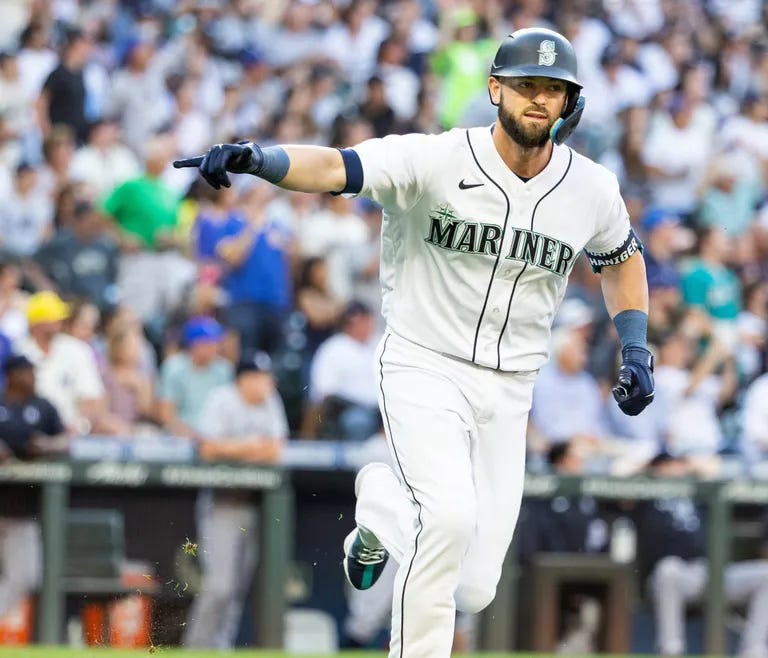Mitch Haniger's market & the path back to Seattle
The Mariners right fielder is set for free agency.
Mitch Haniger has been the Seattle Mariners’ right fielder for five of the last six years and is scheduled to hit free agency this offseason. The soon-to-be 32-year-old recently expressed interest in staying in Seattle.
At some level, the club certainly has interest in keeping Haniger in a Mariners uniform; he’s a run producer and the epitome of the culture the organization has been brewing since Jerry Dipoto and Scott Servais arrived.
How likely it is the two can renew their vows depends very much on how much the market for Haniger develops. Let’s investigate.
Supply and Demand
The demand for average to above-average corner outfielders is typically tepid, and likely will again be this winter as one of the easier positions on the field to fill.
Clubs that may be seriously looking for such assistance this winter include the White Sox, Tigers, Guardians, Padres, Braves, Cubs, Rangers, Red Sox, Brewers, and Giants, plus Seattle, particularly if they let Haniger walk. But only a slight majority of these clubs are in great need and likely to be aggressive in pursuit.
The key here is supply.
LUKE ARKINS: 15 Numbers Mariners Fans Should Consider This Offseason
Joining Haniger in free agency this winter are the likes of Wil Myers, Joey Gallo, Michael Brantley, Andrew Benintendi, David Peralta, and Brandon Nimmo. Notable corner outfielders that may be available via trade include Cody Bellinger, Ian Happ, Tyler O’Neill, Max Kepler, and Teoscar Hernandez.
At first glance, it appears there are at least as many solutions as there are problems, suggesting a buyer’s environment. If this comes to fruition, Haniger’s market isn’t likely to be particularly strong. In this situation, strong is beyond two guaranteed seasons at an AAV approaching the qualifying offer, set last week at $19.65 million.
Haniger’s Value to Seattle
Zeroing in on Haniger’s value to Seattle moving forward is more than tricky — it’s literally impossible. While Haniger has produced in his time with the Mariners — .263/.337/.480, 107 HR, 124 wRC+ — he’s played in just 530 of a possible 870 regular-season games (61%), including just 57 games in 2022. He’s managed to play more than 96 games in a season just twice in his career (2018, 2021).
If Haniger were to play 140-plus games in 2023, his production would probably be worth the QO, perhaps more. But anything shy of a season worth at least 2.5 wins above replacement and not only is he not worth the dollars, but the club could again be left hurting for a full lineup, much like they were this past season.
How many times did you say while watching the Mariners play this season “man, I wish they were healthy”? And a lot of that was because the club was missing Haniger, who played in just 57 games.
The Unfortunate Truth
Unfortunately, the Mariners, if they wish to take a stable, step or three closer to the World Series, cannot rely on Haniger to the same degree they have been. He needs to be a luxury signing. That doesn’t mean he doesn’t fit, it just means he should not be relied upon to anchor the lineup.
Make Haniger more of a complementary player. An everyday option, sure, just not an indispensable one. How? By adding at least two quality hitters to the lineup this offseason.
Even if the two are merely above average rather than plus — say, Brandon Lowe and Ian Happ — the pair markedly improve the Mariners’ production at second base (28th) and in one of the outfield corners (15th).
The Qualifying Offer
While the QO is in play for the Mariners, the payoff for tendering is only maxed out if Haniger signs with another team for at least $50 million. I’m not even sure squinting really intensely shows a path to that as we sit here in late October.
I spoke to some front office analysts and AGMs over the past few weeks and their best guess is Haniger will NOT receive a QO from Seattle, nor get more than $25-30 million in guaranteed money this winter. One best-guessed a two-year, $25 million deal with incentives up to the $40 million range, and opined the Giants, Padres, Twins, and Tigers as fits.
Conclusion
The questions for the Mariners include:
Do we want to pay Haniger nearly $20 million for one season?
Do we have any interest in a multi-year deal?
If I were the Mariners I’d have interest, albeit limited, in both, but would not be in a rush to commit. The market may change, but it sure seems like Haniger’s opportunity for a big payday is meager, which may end up leading him right back to Seattle on a relatively club-safe deal.
Which, by the way, is probably ideal for both sides, especially since Haniger returning may be the best scenario for Seattle’s offense in 2023.



